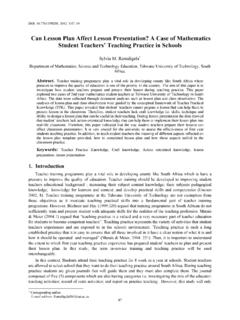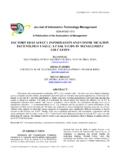Transcription of Prejudice Reduction through Multicultural …
1 Social Studies Research and Practice Volume 2, Number 2, Summer 2007 ISSN: 1933-5415 219 Prejudice Reduction through Multicultural education : Connecting Multiple Literatures Steven P. Camicia Utah State University Abstract Banks (1994) names Prejudice Reduction as one of five dimensions of Multicultural education . Although children develop prejudicial beliefs, attitudes, and values at young ages, research demonstrates that when Multicultural knowledge and values are combined with intergroup contact, Prejudice is often reduced. In this article, I connect multiple literatures in order to present an overarching picture of Prejudice and its Reduction in classrooms. First, I describe some negative impacts of Prejudice and how Prejudice develops at very young ages. Second, utilizing another of Banks s dimensions of Multicultural education , I describe the knowledge construction process as a necessary factor in Prejudice Reduction . Finally, intergroup contact theory and complex instruction are described as a guide for reducing Prejudice in classrooms.
2 Introduction Prejudicial attitudes and beliefs undermine principles of social justice in a liberal democracy. Prejudice in schools is especially troubling because schools are public places in which students learn to negotiate and construct knowledge of differences. When prejudicial beliefs go unexamined in schools, students are not given the opportunity to deconstruct prejudicial knowledge. The impact of prejudicial attitudes on students is wide ranging, spanning from lower school performance to poor physical and mental health. For example, Pang, Kiang, and Pak (2004) describe the experiences of Asian Pacific American students who face prejudicial attitudes concerning expectations of high academic performance. Individual Asian Pacific American students are often expected to excel in academics based upon aggregate group data regardless of their individual needs or abilities. These prejudices combine with family expectations to produce high levels of stress in students.
3 As a result, some Asian Pacific American students report higher incidences of depression and suicidal thoughts than their European American peers. The Reduction of Prejudice is vital for equitable and vigorous learning environments that foster students academic, mental, and physical health. The harm of prejudicial attitudes is not always explicit (Fiske, 2002; Steele, 1997). Steele describes a phenomenon termed stereotype threat whereby students perceive prejudicial attitudes related to their expected performance in a school subject, and as a result, their performance Social Studies Research and Practice Camicia declines in the subject. For example, when female students perceived prejudicial attitudes in the area of mathematics, their performance in mathematics suffered. Because stereotype threat is, as Steel describes it, in the air, the inequity of student learning and assessment is concealed, and norms supporting prejudicial attitudes are reinforced.
4 When students experience Prejudice in school, they sometimes disengage from school because they disassociate the setting of school from their overarching identities (Spencer, 1982; 1983; 1985; Steele, 1997). This is a way to disassociate self-identity with tasks and settings that are prejudicial. This is dire because disassociation with school often leads to school failure. Prejudice Reduction as part of Multicultural education decreases student disassociation with school, leading to learning environments that affirm the values of equitable education and social justice. Prejudice Reduction is a necessary component of Multicultural education (Banks, 1994). Educators are in unique positions to improve intergroup relations inside and outside of school because public schools offer two resources: differences and common goals (Parker, 2003). It is within this social milieu that Multicultural education and Prejudice Reduction can transpire. When students attempt to express differences and reach cooperative goals ( , solve a science problem or deliberate socially just rules in their school), they can gain perspective consciousness of their classmates and others.
5 In other words, students can become aware that there are multiple perspectives concerning social conditions or the best course of action for their community (Camicia, 2007). Multicultural education helps students see these multiple perspectives with an eye toward ending social oppression (Kumashiro, 2003). In the following review, I attempt to make connections between multiple literatures in order to paint an overarching picture that will guide educators toward reducing Prejudice in their classrooms. I discuss how Prejudice develops from a young age and how educators can play a significant role in reducing prejudicial knowledge, beliefs, and values. Prejudice and Its Development In an effort to promote Prejudice Reduction through Multicultural education , it is first helpful to understand the nature and development of prejudicial attitudes and beliefs. Prejudice occurs when negative attitudes concerning a social group are extended toward an individual based upon that individual s perceived membership in the group (Stephan, 1985; Stephan & Stephan, 2001).
6 The group categories upon which these negative attitudes are based can be wide-ranging, including categories such as race, social class, gender, religion, age, sexuality, ability, and ethnicity. Dovidio et al. (2004) describe prejudicial attitudes as having cognitive, affective, and behavioral components. Successful Multicultural education addresses each of these components in the Prejudice Reduction process. First, the cognitive component of Prejudice encompasses the negative thoughts or beliefs students have concerning an individual or group. School sites are ideal social milieus for examining prejudicial knowledge when such examinations are sanctioned by educators. Later in this article, I discuss the role of knowledge construction in dismantling prejudicial knowledge. Second, an affective component of Prejudice entails negative student feelings about a target person or group. Under optimal conditions of intergroup contact in a Multicultural curriculum, students are able to build positive affective ties with peers by placing value upon these relationships (van Dick et al.)
7 , 2004). Third, a behavioral component of Prejudice influences students prejudicial attitudes when they consider past or future experiences 220 Social Studies Research and Practice Camicia with a target person or group. Students can examine past experiences with intergroup contacts and role-play future contacts with positive behavioral outcomes. Prejudice Reduction is possible when Multicultural education targets cognitive, affective, and behavioral components, and as a result, negative intergroup prejudices are transformed into positive intergroup relationships. Because Prejudice develops at very early ages, Prejudice Reduction often involves an examination of longstanding unexamined beliefs. Although social categorization is a natural process of cognition (Fiske, 2002), the cues for learning categorization and prejudicial attitudes are derived from an environment that reflects fundamental inequities. The construction of prejudicial knowledge is reinforced through a child s perception of these inequities (Spencer, 1985).
8 Biases in young children serve as powerful examples of the pervasive power that societal Prejudice has upon social reproduction and the knowledge construction process. Spencer (1982, 1983) found that white bias is a reflection of children constructing prejudicial knowledge of society rather than their constructing prejudicial knowledge toward themselves. Children learn very early through a variety of sources about the answers that society gives to questions concerning cultural preferences. Children mirror white bias in a cognitive process that mimics the values of the society that children are embedded, but the adoption of such a bias in children of color does not necessarily influence self-esteem. Spencer and Markstrom-Adams (1990) write: Cognitive awareness appears to support the acquisition of pro-majority group or Caucasian-oriented attitudes among racial or ethnic minority children. Such results may not necessarily suggest misidentification or self-rejection in the case of very young children.
9 Given the more positive attributes credited to white stimuli, instead, the response pattern may reflect young children's identification (of the self) with the (perceived) more valued stimuli. (p. 296) Within a milieu of intersecting social contexts and cues, individuals attempt to construct judgments that reflect prejudicial attitudes based upon the prevalent judgments of mainstream society. In other words, prejudicial attitudes and beliefs concerning society are internalized by all who are part of society, regardless of whether individuals benefit or suffer from mainstream attitudes and beliefs. This defines hegemony whereby social inequalities are maintained by prejudices that strengthen consent to one social group s domination of other social groups (Gramsci, 1972). Prejudice Reduction in Multicultural education aims at creating learning environments where the societal prejudices that fuel hegemony are not reproduced in classrooms. The following section discusses ways that teachers can help students deconstruct prejudicial knowledge.
10 Prejudice Reduction : Knowledge Construction Banks (1994) includes knowledge construction as another dimension of Multicultural education . The process of knowledge construction is simultaneously a process of knowledge deconstruction. As students examine alternate narratives of out-groups, they begin the deconstruction of hegemonic mainstream narratives that perpetuate social inequality. For example, rather than a monolingual voice in subjects such as history, students are able to listen to many voices that describe history from a variety of perspectives. By studying multiple perspectives, students develop the ability to analyze inconsistencies that serve to perpetuate 221 Social Studies Research and Practice Camicia inequalities. Banks (2002) writes, By revealing and articulating the inconsistency between the democratic ideals within a society and its practices, transformative knowledge becomes a potential source for substantial change (p. 22).













